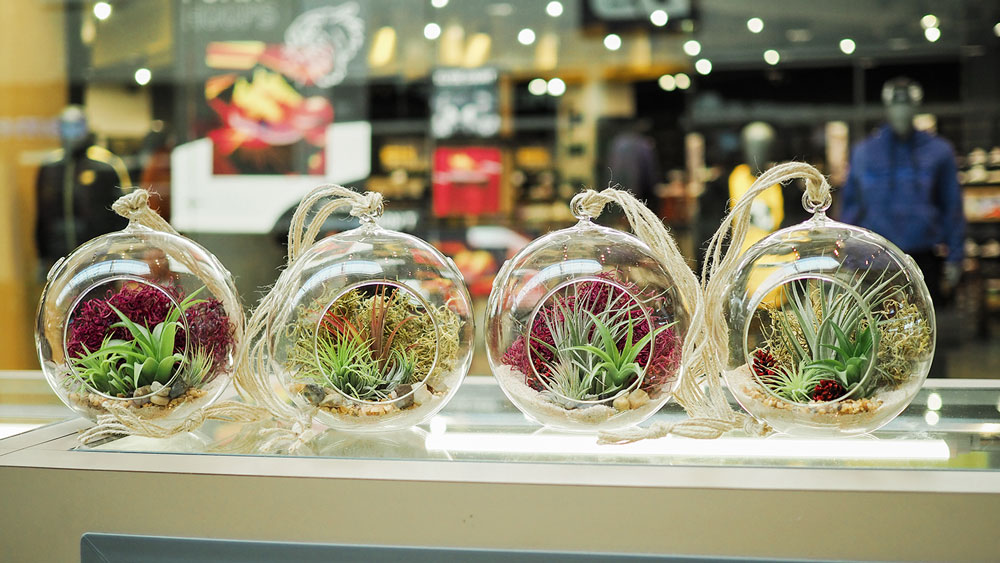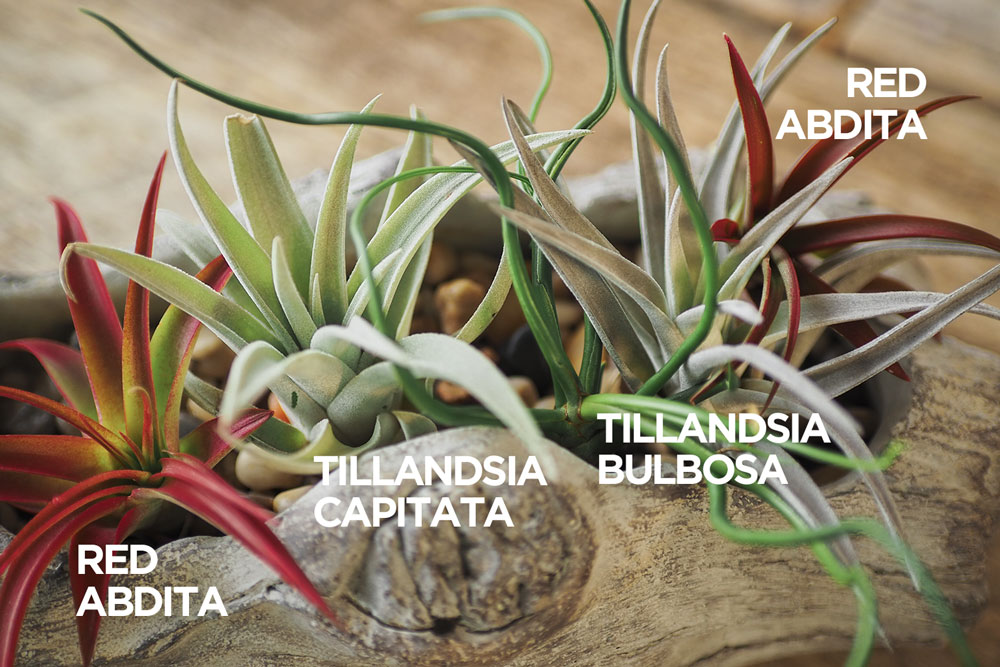Air plants, also known as Tillandsia, have become increasingly popular houseplants over the last few years. Their easy care requirements, unique appearance and versatility make them an excellent addition to both home and office spaces. In this comprehensive guide, we’ll explore the most popular ways people are using air plants to decorate their living environments.
Air plants, or Tillandsia, are a type of epiphyte that can grow without soil They absorb moisture and nutrients through scales on their leaves, eliminating the need for potting mix or frequent watering. There are over 650 species of air plants, displaying a wide variety of shapes, sizes and foliage types. Many have striking blooms in shades of red, orange, yellow, pink and purple.
Air plants are native to the warmer climates of Central and South America. However, their adaptability makes them suitable for growing indoors anywhere in the world. With the proper care, air plants can thrive for several years. Their low maintenance and visually appealing nature make them perfect for enhancing indoor spaces.
Popular Uses for Air Plants
Here are some of the most common ways people are using air plants to add beauty and interest to their homes
Mounted in Open Air
One of the easiest ways to display air plants is by mounting them in open air. You can mount air plants on pieces of weathered driftwood, sea shells, rocks or directly onto a wall. This mimics how they grow in nature by attaching to trees and rocks with their scaled rhizomes.
When mounting, use fishing line, floral wire or glue to securely attach the air plant. Make sure not to cover any of the foliage – you want the air to circulate freely so the plant can absorb moisture. Air plants mounted in open air make excellent living wall art.
Displayed in Glass Terrariums
Placing air plants in glass terrariums or hanging globes is an extremely popular trend. Terrariums provide humidity while neatly showcasing the plants within. They bring life and greenery to kitchens, bathrooms, offices and more.
When placing air plants in terrariums, opt for wide, shallow containers to allow air flow. Water sparingly, leaving the lid off for a few hours each week. This prevents excess moisture from building up inside.
Hanging from the Ceiling
Let your air plants hang free by suspending them from the ceiling in glass globes, wire baskets or macrame. Hanging air plants add height and dimension to any space. They are beautiful above kitchen sinks, in sunrooms or clustered together in a corner.
Ensure the air plants have room to grow and aren’t crowded. Water them by taking them down and soaking 1-2 times per month. Let them drip dry before replacing in their hanger.
Nestled into Houseplant Groupings
Use air plants to add intrigue and texture among your other houseplants. Tuck them between trailing pothos vines, alongside cacti or in the nooks of tropical plants. Contrasting shapes and colors make for dynamic displays.
Since air plants don’t require potting mix, you can simply situate them among other plants without actually planting them. Just make sure to remove and water them as needed.
Accenting Shelves
Air plants are the perfect size for accessorizing shelves, counters, tabletops and other flat surfaces. Display a few choice specimens in pretty ceramic bowls or watering globes. Mix with other curios like shells, stones and mini terrariums.
Keep the air plants looking tidy by trimming dead leaves and removing offsets as needed. Dust their leaves occasionally with a soft paintbrush.
Inside Mason Jars or Terrariums
For a cute and quaint display, plant air plants inside hanging mason jars or tabletop terrariums. Being under glass helps increase humidity while adding a unique touch. Adorn with sand, pebbles, moss and found objects from nature.
Water conservatively, leaving the jar lid off for ventilation if condensation builds up inside. Wipe the glass with a cloth to keep it looking clean.
Incorporated into Wreaths
Add an unexpected twist to your wreaths by tucking in air plants. Holiday wreaths get a contemporary update with the addition of living air plants. For an everyday wreath, use grapevine, eucalyptus or dried plants as a base. Wire or hot glue the air plants in place.
Keep wreaths alive by periodically removing and watering the air plants. Some shedding of leaves is normal – simply pull off the dead foliage.
Mounted to Decor Items
Take basic decor items from boring to fabulous by affixing air plants. Adhere them to items like wooden plaques, large seashells, ceramic dishes, framed glass and more. You can use hot glue, wire, waterproof tape or other adhesives to attach them.
This is a great way to upcycle thrift store finds or items you already have at home. The air plants add natural elegance wherever featured.
Made into Art
Don’t limit yourself to traditional displays – turn your air plants into art! Get creative with items like picture frames, shadowboxes, driftwood, rocks, and other objects by affixing air plants in aesthetic ways.
You can also paint terra cotta pots or wooden backings to match your decor. Display a few choice specimens for a simple yet artistic accent. The possibilities are endless!
Featured in Weddings
Air plants are gaining popularity as additions to wedding ceremonies and receptions. Their versatility allows them to be used many ways – in bouquets, boutonnieres, table centerpieces and more.
Some specific ways to use air plants at weddings include:
- Tucked into bridal bouquets
- Wired into boutonnieres
- Adorning ceremony aisles or altar arrangements
- Placed in tabletop terrariums as centerpieces
- Used in floral arrangements around the venue
Caring for Air Plants In the Home
Air plants are quite adaptable, but provide the best results when a few basic care guidelines are followed:
- Place in bright, indirect light. Avoid full sun.
- Water 1-2 times per week by misting or soaking; let fully dry out between waterings.
- Provide good air circulation and ventilation.
- Grow in indoor temps between 60-80°F.
- Occasionally fertilize with a dilute foliar houseplant fertilizer.
- Dust leaves periodically to keep them looking their best.
With the right care, air plants can thrive for many years in the home. Their versatility and uniqueness make them a refreshing alternative to traditional houseplants.
Final Thoughts
As you can see, there are limitless possibilities when it comes to creatively using air plants throughout your living space. They require so little care that you can place them anywhere you desire a burst of green.
Next time you’re looking to add natural beauty to your home, office or event, consider using versatile and low maintenance air plants. They allow you to easily add a living touch without a lot of effort.

Tillandsia plants, better known as Air Plants, are growing in popularity year over year. The question I keep hearing is, “These are interesting for sure, but how do I display air plants?”
To be honest, it’s a bit more freeing, because with air plants, ANY container is going to work. There is no need for soil and no worries about good drainage, so anything from teacups to glass containers are appropriate for displaying air plants.

What are Air Plants?
- Tillandsia, the botanical name, is a genus of plants with more than 600 different species. The common name is Air Plant which is how most of us know them. So air plants are Tillandsia and vice versa.
- Tillandsias are epiphytes. In their natural environment air plants grow on other plants—clinging to trees or rocks—rather than by rooting in the ground. They will grow on bushes, rocks, and shrubs. For my readers in the United States, you might be familiar with Spanish Moss. The botanical name is Tillandsia Usneoides.
- The bottom line is this type of plant uses roots to attach to a host, but absorbs moisture and nutrients from the atmosphere via its leaves. This is why they are found in humid environments. Humid zones have much higher levels of moisture in the air, and since this plant genus absorbs what it needs from the ambient environment, then it only makes sense they need to live in a humid zone.
In a home setting, this means air plants don’t need to be potted in soil. They are unconcerned with drainage so any decorative container will beautifully display them.

The biggest misconception is that air plants live off of air alone. Well, in their natural habitat, sort of. In your living room? No way.
51 Most Amazing Air Plant Display Ideas (part I)
FAQ
Where is the best place to put an air plant?
What can you do for air plants?
What are the uses of air plant?
